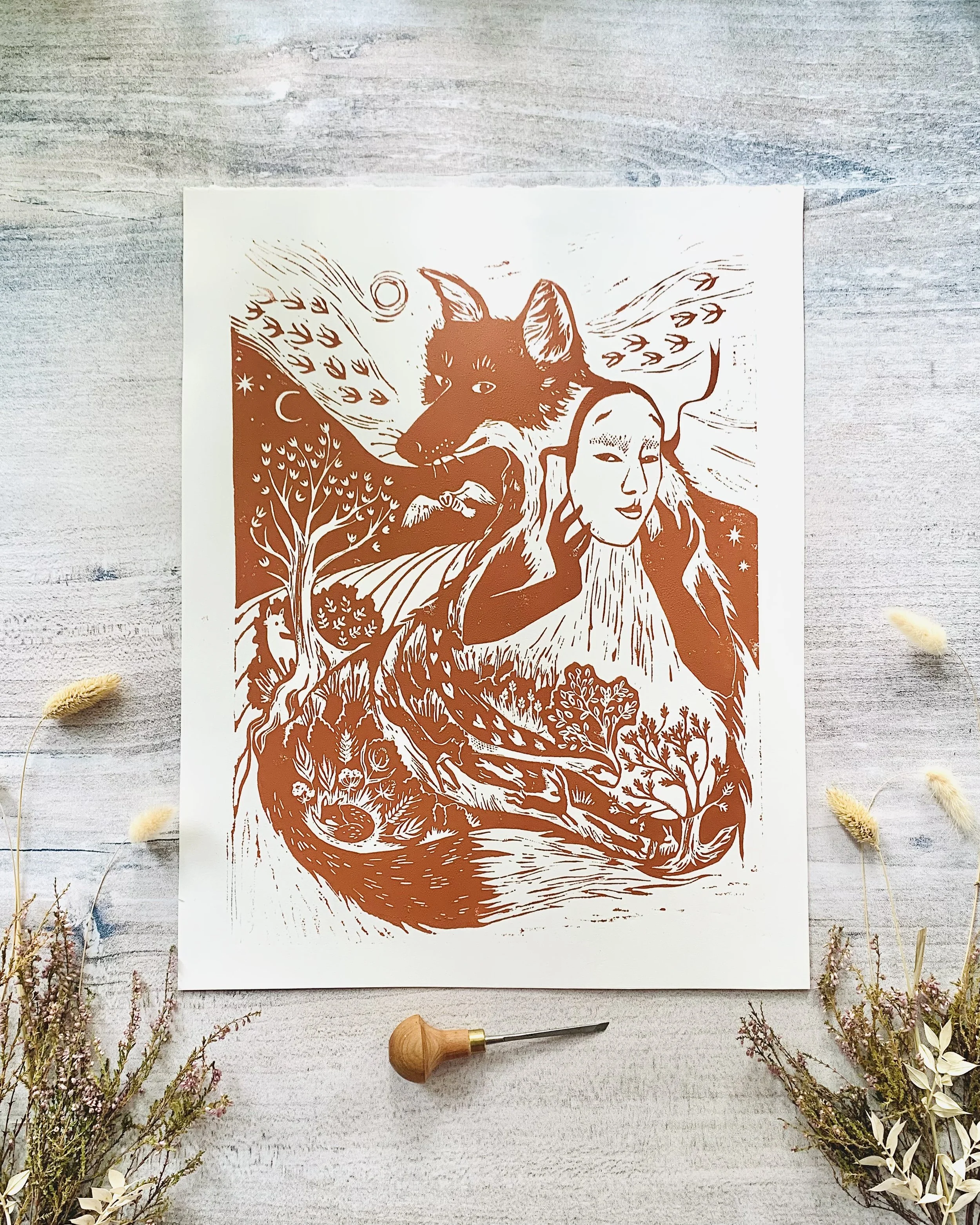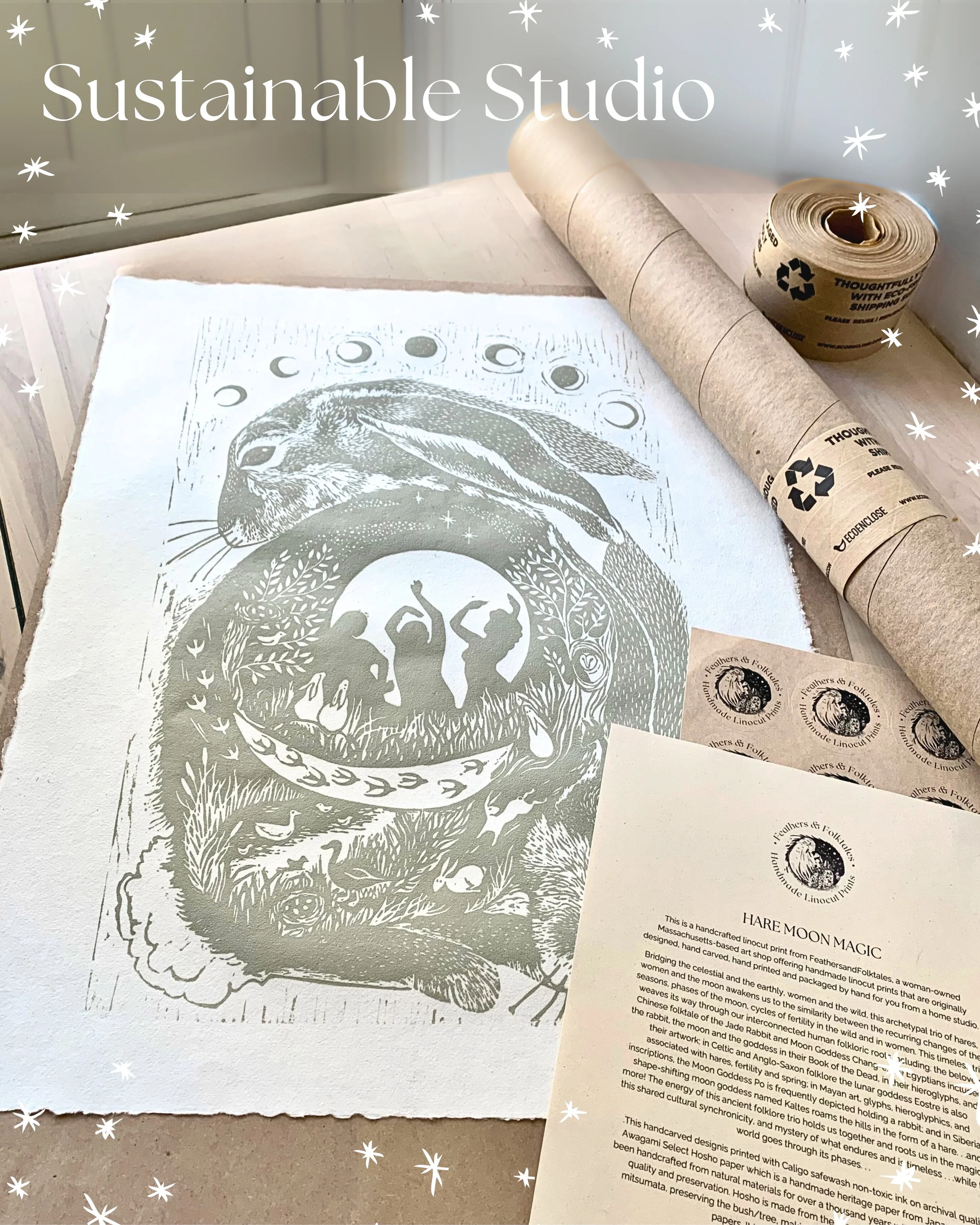Sustainable studio
As an artist, I choose my materials with a commitment to sustainability, while also making intentional, artful selections that honor high-quality craftsmanship and a reverence for tradition.
Non-Toxic Archival Inks
For my linocut prints I use Caligo safe-wash non-toxic Inks which do not require hazardous solvents like white spirit or turpentines for cleaning up. Cranfield Inks are at the forefront of the developments in non-toxic printmaking balancing environmental considerations with the longevity and quality of the printing product. (I also use Seventh Generation soap for my clean-ups!) Caligo Safe Wash Relief inks include beautiful pigments, finely ground into the purest colors for archival results.
Natural Linoleum
FeathersandFolktales uses natural linoleum, which is different from synthetic versions or vinyl, and is made from: vegetable drying oil, natural rosin, wood flour, and limestone, wood flour, rosins, powdered cork, jute and linseed oil.
The PapeRs USED
Handcrafted Papers
At FeathersandFolktales, select art prints are created using Hosho and Hanji papers—traditional Japanese and Korean papers made by hand from natural fibers, steeped in centuries of artisanal heritage. With their rustic texture, soft deckled edges, and enduring strength, these papers echo the spirit of old-world storytelling—materials as timeless and evocative as the folktales that inspire each piece.
Strathmore & STONEHENGE
At FeathersandFolktales, many prints are made on Strathmore and Stonehenge papers—archival-quality materials that balance fine art integrity with environmental consciousness. Strathmore, a bright white, smooth 100% cotton paper produced locally in Massachusetts, offers crisp detail and a modern feel. Stonehenge, a U.S. made, heavyweight cotton-based paper made with alternative energy and salvaged plant fibers, is EMS-certified and tree-free—offering an eco-conscious foundation for work rooted in storytelling, nature, and timeless craft. Both these papers are sustainable choices for U.S.-based collectors.
Arnhem 1618®
Select prints are also made on Arnhem 1618®—a 100% cotton, acid-free printmaking paper crafted by the historic Schut Papier mill in the Netherlands, in operation since 1618. With its softly textured vellum finish, substantial weight, and natural deckled edges, Arnhem offers a beautiful balance of modern performance and centuries-old craftsmanship, enhancing the depth and clarity of linocut work with quiet elegance..
Some considerations that go into my choice of paper include:
1) aesthetic appeal: selecting the best paper to match the design and color of the print itself;
2) the intricacy of the design (usually thinner lightweight paper can more effectively capture tiny details);
3) sustainability;
4) the size of the paper compared to the size of the print and whether I need to cut it to size, this takes more time so I am balancing the time of doing this with offering quality prints time-efficiently.
Eco-Friendly Packaging & Shipping
Some sample packaging materials from EcoEnclose
How a handmade print is packaged for shipping
FeathersandFolktales uses many packaging and shipping products from EcoEnclose including: the cardboard mailing envelopes; packing tape; and recycled clear bags. The cardboard envelopes are made from 100% recycled paperboard, 90% of which is post-consumer recycled content. Stiff and sturdy, this mailer ensures your art prints stay flat in transit while at the same time contributing to the long-term benefit of our planet. All prints are enclosed in a 100% recycled plastic sleeve protecting the art from dust, dirt and moisture. Both the mailer and clear bag are recyclable.
Prints larger than 11” x 14” are rolled in Kraft paper and enclosed in an EcoEnclose recycled plastic sleeve, and mailed inside a cardboard tube made from 100% recycled paperboard primarily from post-consumer waste from YazooMills which is recyclable and manufactured in the USA. Some smaller prints are mailed in Uline Kraft paper tubes which are not made of recycled materials.
My prints are for sale on Etsy, which offsets 100% of carbon emissions from shipping and packaging of every delivery. Etsy also is committed to reaching net zero emissions by 2030.
Eco-Friendly Clean-up
Printmaking is messy and cleaning up is time-consuming! I use bamboo toothbrushes, natural sponges and either Seventh Generation or Ecos Plant Powered laundry detergent to clean up the safewash inks.
More
All purchases using a credit card via this website are processed through STRIPE which commits 2% of every linocut print sale towards Frontier, a collaborative initiative that accelerates the development of carbon removal technologies by guaranteeing future demand for them. Recently STRIPE funded 14 early-stage carbon removal companies and based on their own projections, these companies could collectively remove more than half a million tons of CO₂ annually by 2026. Learn more.
Finally, cleaning up after printing is a laborious process, but I use seventh generation biodegradable soap, recycled paper towels, and bamboo toothbrushes (to get the ink out of the small crevices in the linoleum).






